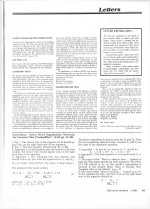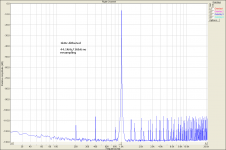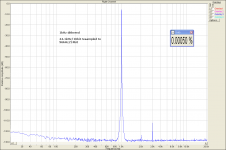Thanks for the link, Dan, I'll check it out ...View attachment 395390
Hi Frank, I recently discovered this VIRTUAL DJ SOFTWARE - Download VirtualDJ Home FREE due to a DJ friend obtaining a dedicated hardware controller for this DJ software.
The thing I like about this player software the ability to instantly and seamlessly crossfade between two 'same but different' recordings.
Foobar is not "bad", but it takes the positive, edge off the sound, deadens it to some degree - on my setup at least - silly things like not being to minimise the ABX window just annoy me. Audacity does 'degrade' also to some degree, but the usefulness of the interface for playing with switching makes up for that - and, I can adjust the interface so what it's doing doesn't get in my face .
I tried foorbar years ago, and immediately said, nahh! I've gone through a number of players, and I always keep coming back to Nero ...
It does make sense of course, because 95% of the time that's exactly how it's going to be listened to.A.Wayne,
I agree it is amazing to be in the studio and watch them listen on a pair of Auratones or go out to the car to decide the final mix. Boggles the mind that anyone would do that but that is the reference that they seem to go by, how will it sound on the worst reproducer.
I've typically found that a favourite old song always "works" for me on normal, 'mediocre' gear; then listening over a typical more hifi system all the good bits, that I enjoyed before, seem to disappear, and I hear only mediocre or irritating; then, finally, on optimum playback everything snaps together, and the sense of the musicians, and the studio crafting something to be enjoyed returns - it's not the same as listening on poor gear, you can now hear 'behind the curtain', but it is immensely satisfying, because it sounds good, and you appreciate the skill and effort that went into putting the whole thing together.
Agreed.......Not mutually exclusive............Most have a little@hitsware,
You may need to re-val such fallacies, I can listen to the crappy radio and no 1&2 are not mutually exclusive ...
of both..........BUT !......They are separate 'modes'
Scott
I had a second look on C. Bateman’s article.
The bridge (a pair of 50W HP8721A reflection bridges and a directional coupler) was used solely for reflection measurements, i.e. viewing the forward and reflected waves (see pages 6, 30)
For the impedance measurements Mr. Bateman used a HP4815A (see page 2).
This is a driving point vector impedance meter, 5Hz-108MHz and sure it can give good measurements.
The question is how these measurements were performed with this instrument.
As I read here (section III )
http://www.hpmemory.org/an/pdf/an_86.pdf
for transmission line measurements, the line has to be either ¼ or 1/8 wavelength long for the selected frequency.
If one of these resonance techniques were utilized but the cable length was not ¼ or 1/8 wavelengths, then results would be wrong.
George
I had a second look on C. Bateman’s article.
The bridge (a pair of 50W HP8721A reflection bridges and a directional coupler) was used solely for reflection measurements, i.e. viewing the forward and reflected waves (see pages 6, 30)
For the impedance measurements Mr. Bateman used a HP4815A (see page 2).
This is a driving point vector impedance meter, 5Hz-108MHz and sure it can give good measurements.
The question is how these measurements were performed with this instrument.
As I read here (section III )
http://www.hpmemory.org/an/pdf/an_86.pdf
for transmission line measurements, the line has to be either ¼ or 1/8 wavelength long for the selected frequency.
If one of these resonance techniques were utilized but the cable length was not ¼ or 1/8 wavelengths, then results would be wrong.
George
1Frank,
I am not saying that the quality of the recording is terrible but they do play with the EQ so that it will not sound terrible on a speaker that can't handle the bass or give the top end a tweek to boost it for mediocre top end. Now you can correct the EQ on your own system if you have some sort of tone controls or outboard eq but why should you have to do that. I know the answer, most people have lousy equipment, the general public and that is who is paying for the music, not those of us with now rare high quality sound systems. No great system is just going to automatically correct this skewed response curve just because it is better equipment, that isn't going to happen.
I am not saying that the quality of the recording is terrible but they do play with the EQ so that it will not sound terrible on a speaker that can't handle the bass or give the top end a tweek to boost it for mediocre top end. Now you can correct the EQ on your own system if you have some sort of tone controls or outboard eq but why should you have to do that. I know the answer, most people have lousy equipment, the general public and that is who is paying for the music, not those of us with now rare high quality sound systems. No great system is just going to automatically correct this skewed response curve just because it is better equipment, that isn't going to happen.
I agree that the EQ can seem OTT, but in my personal experience when a system rises to a sufficient quality level then the EQ issues evaporate, my ears automatically compensate for unbalanced FR, it doesn't irritate - the music just "makes sense".
In fact, this has been one of my quality 'metrics' for a long time - if I can fiddle with EQ while playing and subjectively this barely, or doesn't register at all subjectively, then I'm in pretty good shape. As an 'extreme', push treble boost to the absolute maximum, if the "quality" doesn't get worst, just the impact somewhat changes - that type of thing ...
In fact, this has been one of my quality 'metrics' for a long time - if I can fiddle with EQ while playing and subjectively this barely, or doesn't register at all subjectively, then I'm in pretty good shape. As an 'extreme', push treble boost to the absolute maximum, if the "quality" doesn't get worst, just the impact somewhat changes - that type of thing ...
Unfortunately, Pavel, this is in the hairy area of the internals of the PC altering the quality of reproduction, depending upon precisely how the file is accessed, processed while playing, etc. In diyAudio this will bring the wrath of the objectivists down upon one with full force, but the truth for me is, with my setup, that it is too much of a factor impacting the quality.
How, pray, if you are spitting digital out to a DAC, or is the problem in your head
Marce, I hope you learned something new from PMA's (even SY's) responds to your statement. The data is not wrong. It is how you and the audiologist drew the conclusion.
Nope. I stand by my comment and who it is aimed, and it is not people such as Sy or PMA. It wasn't me or the audiologist, it was a test for the US Armed Forces, so there were some clever people involved. But it is the sort of reply I* expect, how often do you get your ears tested including frequency response?
But then you consider me tone deaf, so whats the worry, because I cannot distinguish the sound difference between well engineered cables or copper and silver cables.
I 2was referring specifically audiophiles who are ears only....you know who you are.
See what I mean, Pavel ...How, pray, if you are spitting digital out to a DAC, or is the problem in your head
Since I have an 'imperfect' PC, with an 'imperfect' DAC on the motherboard, it tends to get affected by processing hash, noise, within the box. So, I do what works to lower this level of interference - including changing the software used, which alters the spectrum of that noise.
It's all pretty simple, really ...
Edit: Of interest to Dan, I've downloaded that DJ software he mentioned,and it's a no-go at the moment: the interface is brimming with eye candy, the CPU is working hard to keep all the fancy dials, etc, spinning while playing the track - and the SQ is walloped badly, for me. If there is a way of dumbing down the interface, to get a lift in quality then it may be a goer - at the moment, not a chance, sorry ...
Last edited:
It may be a question of the DAC used. My external DAC works perfect with 48k and 96k sampling, for the reason of the clock frequency used. For 44.1k and 88.2k it uses internal HW resampler, which is horrible (it creates plenty of artifact spectral lines). You can easily find it by measurement and measurement is the best proof here. To get the best result, I set foobar resampler to 96kHz and ultra mode, instead of using HW resampler in the DAC box. Then I get the best possible result both by spectral measurements and listening. Listening is nice, but tuning by listening only may be misleading and not shooting on target.
Nope. I stand by my comment and who it is aimed, and it is not people such as Sy or PMA.
I wasn't agreeing or disagreeing whether your comment was aimed at SY or PMA or whoever.
It wasn't me or the audiologist, it was a test for the US Armed Forces, so there were some clever people involved.
I wasn't commenting on US Armed Forces or whether there were clever people involved or not.
If you already know very well what PMA was talking about (before or after he mentioned it) then good, nothing new to learn.
My wife doesn't like music but her hearing is very good. You can find similar person with very good hearing. But it doesn't mean much. My wife is quite terrible at assessing direction of the sound and the detailed information of the sound.
I agree measuring with sufficient accuracy would be good, but the absence of the right setup and tools, means the ears will need to be final arbiters for the moment ...Then I get the best possible result both by spectral measurements and listening. Listening is nice, but tuning by listening only may be misleading and not shooting on target.
In essence, hearing high levels of recovered detail without requiring stressful focusing is the standard I use. Say, a modern, quite complex popular music mix, with a large number of sound strands, each with their own level of reverb, and some of these very deep. Lesser playback arrangements make such material harder to digest, it's jangly, irritating, congested in comparison.
I would consider it impossible for a poorer quality replay to make it easier to hear deeper, and more easily, into complex soundscapes.
That's a new idea for me. Hard to agree about because it seems to me that most of us have reflex to pay attention to fidelity, sometimes more than we do to musicality.Anyone ever notice, when you are listening to your favorite song, you don't really notice the fidelity?
But I have long discarded the idea of buying music based on the fidelity of the recording. I bought music based on the musicality. Best singers, best musicians, best songs. It's funny to read recommendation on music with unknown singer, unknown title, unknown etc, you know what I mean.
I Always Wanted To Be A DJ....
What system/OS are you running at present ?.
I will try some listening (an excuse to get the Stax rig out ) on a few different media player softwares and see what gives....if I can pick differences, I'll let you know.
) on a few different media player softwares and see what gives....if I can pick differences, I'll let you know.
The KB shortcuts (wireless KB/Mouse.....Kmart, $19.00) that I have set up in Virtual DJ allow me to start both decks together, and then flick the crossfader instantly between the two tracks playing (Z/X).....no momentary mutes or glitches whatsoever.....another KB shortcut to rewind both tracks to beginning (M), another is Play/Pause (Spacebar).
Ergonomically this KB shortcut arrangement works particularly well for me for comparing two similar recordings, in this case comparing recordings of the same but temporarily physically modified interconnect (loopback) cable.
Being able to instantly and seamlessly switch between tracks helps immensely with quickly identifying and characterising very fine audible differences.
I have not found any other software that gives me this ergonomically perfect KB functionality, combined with glitch/mute free changeover.....Foobar ABX is a complete fail in this important respect.
Advice of other suitable/capable media player softwares is welcomed.
Dan.
Hi Frank, Ok, I'm running a Toshiba 18" laptop, WIN 8 Pro 64bit, i7 processor, 8Gb Ram etc, into an Edirol UA-25ex USB audio interface.....so no processor speed bottlenecks in this case.Edit: Of interest to Dan, I've downloaded that DJ software he mentioned,and it's a no-go at the moment: the interface is brimming with eye candy, the CPU is working hard to keep all the fancy dials, etc, spinning while playing the track - and the SQ is walloped badly, for me. If there is a way of dumbing down the interface, to get a lift in quality then it may be a goer - at the moment, not a chance, sorry ...
What system/OS are you running at present ?.
I will try some listening (an excuse to get the Stax rig out
 ) on a few different media player softwares and see what gives....if I can pick differences, I'll let you know.
) on a few different media player softwares and see what gives....if I can pick differences, I'll let you know.The KB shortcuts (wireless KB/Mouse.....Kmart, $19.00) that I have set up in Virtual DJ allow me to start both decks together, and then flick the crossfader instantly between the two tracks playing (Z/X).....no momentary mutes or glitches whatsoever.....another KB shortcut to rewind both tracks to beginning (M), another is Play/Pause (Spacebar).
Ergonomically this KB shortcut arrangement works particularly well for me for comparing two similar recordings, in this case comparing recordings of the same but temporarily physically modified interconnect (loopback) cable.
Being able to instantly and seamlessly switch between tracks helps immensely with quickly identifying and characterising very fine audible differences.
I have not found any other software that gives me this ergonomically perfect KB functionality, combined with glitch/mute free changeover.....Foobar ABX is a complete fail in this important respect.
Advice of other suitable/capable media player softwares is welcomed.
Dan.
Last edited:
Good info, thank you.It may be a question of the DAC used. My external DAC works perfect with 48k and 96k sampling, for the reason of the clock frequency used. For 44.1k and 88.2k it uses internal HW resampler, which is horrible (it creates plenty of artifact spectral lines). You can easily find it by measurement and measurement is the best proof here. To get the best result, I set foobar resampler to 96kHz and ultra mode, instead of using HW resampler in the DAC box. Then I get the best possible result both by spectral measurements and listening. Listening is nice, but tuning by listening only may be misleading and not shooting on target.
Dan.
I realize that many here are trying to make comparisons with the equipment that they have and this involves both computer hardware and software.
I don't use this method, because it is too 'iffy' as far as the source quality.
I don't particularly like mechanical switching either, but it IS better, if done correctly.
I did not initially ignore double blind testing, but tried to make it work, and I, even then, found problems with the hardware:
I don't use this method, because it is too 'iffy' as far as the source quality.
I don't particularly like mechanical switching either, but it IS better, if done correctly.
I did not initially ignore double blind testing, but tried to make it work, and I, even then, found problems with the hardware:
Attachments
Read what I said, putting it out to a DAC, not an internal one, though there are many who say some sound cards are excellent. I aint gonna get into PC noise with you, that's your personal preference, me I ISOLATE my PC from the rest of my system so I am not affected by PC noise, but that is engineering practice, noise control.
I would consider it impossible for a poorer quality replay to make it easier to hear deeper, and more easily, into complex soundscapes.
Such as a PC say with all that software running and gates switching
Good info, thank you.
Dan.
Thank you Max, two pictures above any verbal tractatus:
Attachments
- Status
- Not open for further replies.
- Home
- Member Areas
- The Lounge
- John Curl's Blowtorch preamplifier part II


